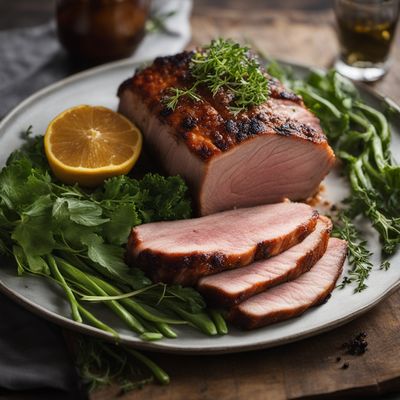
Ingredient
Ham, pork
"The Savory Delight: Unveiling the Secrets of Ham and Pork"
Ham and pork, derived from the meat of pigs, are renowned for their succulent taste, tender texture, and marbled appearance. Ham is typically cured and smoked, resulting in a savory, slightly salty flavor, while pork offers a milder taste that can be enhanced with various seasonings and cooking methods. Both ingredients are prized for their versatility, making them suitable for a wide range of dishes, from hearty stews to delicate charcuterie boards.
Origins and history
The consumption of pork dates back thousands of years, with evidence of pig domestication found in ancient civilizations such as China, Egypt, and Greece. Pork has played a significant role in various cultures, often symbolizing prosperity, abundance, and celebration. Ham, specifically, has a long history, with the curing and smoking techniques originating in Europe during the Middle Ages. These preservation methods allowed ham to be stored for extended periods, making it a valuable food source during times of scarcity.
Nutritional information
Ham and pork are excellent sources of protein, essential vitamins such as B12 and B6, and minerals like zinc and selenium. However, they can also be high in fat, so moderation is key. A 3-ounce serving of ham contains approximately 150 calories, while the same serving size of pork provides around 250 calories.
Allergens
Pork can be allergenic for individuals with pork-specific allergies or sensitivities.
How to select
When selecting ham or pork, look for cuts that have a vibrant pink color, firm texture, and minimal visible fat. For ham, choose varieties that have been properly cured and smoked, ensuring a balanced flavor. When purchasing pork, opt for cuts with a good ratio of lean meat to fat, as this will contribute to tenderness and juiciness.
Storage recommendations
To maintain the freshness and quality of ham and pork, store them in the refrigerator at temperatures below 40°F (4°C). Wrap them tightly in plastic wrap or place them in airtight containers to prevent moisture loss and avoid cross-contamination with other foods. Cooked ham and pork should be consumed within 3-4 days, while raw cuts can be stored for up to 5 days.
How to produce
Amateur enthusiasts can raise pigs for pork production by providing them with a suitable environment, proper nutrition, and veterinary care. However, the process requires knowledge of animal husbandry and compliance with local regulations.
Preparation tips
Ham can be enjoyed as is, thinly sliced for sandwiches or charcuterie boards, or incorporated into various dishes such as soups, stews, and quiches. Pork can be prepared in numerous ways, including roasting, grilling, braising, or stir-frying. Marinating pork before cooking can enhance its flavor and tenderness. It is important to cook pork thoroughly to ensure food safety, with an internal temperature of at least 145°F (63°C) for whole cuts and 160°F (71°C) for ground pork.
Substitutions
For ham, suitable substitutes include prosciutto, Canadian bacon, or smoked turkey. As for pork, chicken or turkey can be used as alternatives in certain recipes.
Culinary uses
Ham is a staple in sandwiches, salads, and breakfast dishes like eggs Benedict. It is also a key ingredient in classic dishes such as ham and bean soup, quiche Lorraine, and glazed holiday hams. Pork is incredibly versatile and can be used in a wide range of cuisines, from Chinese stir-fries to Mexican carnitas and Italian porchetta.
Availability
Ham and pork are commonly available in most regions worldwide, as pig farming is prevalent in many countries.
More ingredients from this category
Recipes using Ham, pork » Browse all

Kentucky-style Balanzoni
Southern Comfort Balanzoni: A Taste of Kentucky in Every Bite

Puerto Rican Cordon Bleu
Caribbean Twist on Cordon Bleu

Cuban-Inspired Pulled Pork Sandwich
Caribbean Delight: A Tropical Twist on Pulled Pork Sandwich

New American Style Roasted Pork with Greens
Succulent Roasted Pork with a Twist of Greens

New Mexican Style Stuffed Pork Loin
Spicy and Savory Stuffed Pork Loin with a New Mexican Twist

Chinese-style Eggs Benedict
Egg Fu Yong Benedict

Monmouthshire-inspired Petiscos
Welsh Delights: Monmouthshire-inspired Petiscos

Croatian-style Eggs Benedict
Dubrovnik Delight

Puerto Rican Beef Wellington
Caribbean Twist: Puerto Rican Beef Wellington

Katsudon - Fast Food Style
Crispy Pork Cutlet Rice Bowl: A Fast Food Delight

Budae Jjigae - Croatian Style
Croatian Army Stew: A Fusion of Flavors

Soulful Laplap Delight
Soulful Laplap Delight: A Hearty Fusion of Vanuatuan and Soul Food Flavors
